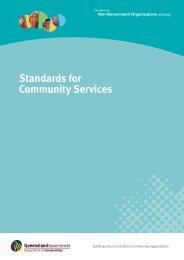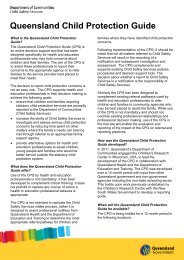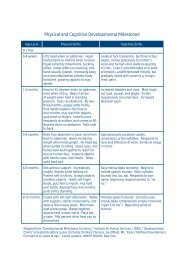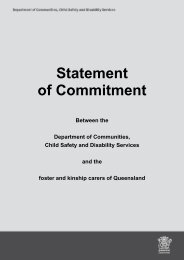Housing and Support Program (HASP): Final Evaluation Report
Housing and Support Program (HASP): Final Evaluation Report
Housing and Support Program (HASP): Final Evaluation Report
You also want an ePaper? Increase the reach of your titles
YUMPU automatically turns print PDFs into web optimized ePapers that Google loves.
of applications, increase Case Manager involvement<br />
with the process, improve the estimation of support<br />
needs, <strong>and</strong> may decrease the risk of inappropriate<br />
clients being nominated.<br />
Notwithst<strong>and</strong>ing the above concerns, there was a<br />
general impression that the appropriateness of <strong>HASP</strong><br />
referrals had improved in recent years. The information<br />
sessions provided across the state by members of<br />
the <strong>HASP</strong> Operational Partnership were seen as being<br />
useful for clinical staff in decision-making around<br />
client selection for <strong>HASP</strong>. Nonetheless, there was<br />
a perception among some support agencies that<br />
mental health staff were using the program to<br />
discharge their most diffi cult clients. Many of these<br />
clients were considered inappropriate for <strong>HASP</strong> as<br />
they required more support hours than could be<br />
provided through <strong>HASP</strong>. This is similar to fi ndings<br />
from earlier work carried out in New South Wales,<br />
which suggests that mental health services nominated<br />
their most disabled clients, many of which were<br />
inappropriate, for the housing <strong>and</strong> support program<br />
(Muir et al., 2006).<br />
A number of stakeholders noted that some clients have<br />
three care plans — a transition plan, a plan developed<br />
by clinical services <strong>and</strong> a plan developed by the<br />
support agency. It is diffi cult to see how a coordinated<br />
approach to service provision can be maintained when<br />
individual clients have up to three care plans. Each<br />
client should have a single care plan which has input<br />
from all stakeholders, including the client. This care<br />
plan should be used to guide interventions with the<br />
client <strong>and</strong> be reviewed <strong>and</strong> updated on a regular basis<br />
— at least every three months.<br />
<strong>Final</strong>ly, communication at the local level can also be<br />
problematic when a range of staff is involved with the<br />
same client. We found that one agency was using a<br />
diary (kept in the homes of clients) to keep a record<br />
of appointments <strong>and</strong> other activities carried out for<br />
clients. All persons entering the home of the client<br />
were encouraged to make an entry in the diary so as a<br />
record of the visit was documented. The diary provides<br />
a record of visitors to the home (including staff), an<br />
audit trail of interventions carried out <strong>and</strong> the date<br />
the interventions were provided. It is suggested that<br />
all support agencies consider using a diary to improve<br />
communication between staff <strong>and</strong> staff, <strong>and</strong> staff<br />
<strong>and</strong> clients.<br />
8.2 The process of providing clinical,<br />
non-clinical <strong>and</strong> housing services<br />
to clients<br />
Clinical Service Provision<br />
Clinical service provision within <strong>HASP</strong> is usually<br />
provided by Case Managers employed by Queensl<strong>and</strong><br />
Health. The primary role of Case Managers is to provide<br />
clinical interventions such as assessment, illness<br />
monitoring <strong>and</strong> treatment. Case Managers were held<br />
in high regard by clients. Many clients attributed<br />
improvements in their health to their Case Managers.<br />
Indeed, over 60% of clients believed that their Case<br />
Manager helped them with their symptoms. Most<br />
clients (89%) indicated that they could get in contact<br />
with their Case Manager if they had a problem.<br />
Both Case Managers <strong>and</strong> support workers expressed<br />
satisfaction with the collaborative working<br />
relationships they have developed. Ninety-fi ve percent<br />
of Case Managers outlined that they valued the<br />
support worker role <strong>and</strong> 92% felt that support workers<br />
had a valuable role to play in the treatment planning<br />
process. Despite this, some support workers felt that<br />
they could have greater involvement in decisions <strong>and</strong><br />
planning around patient care.<br />
<strong>Support</strong> workers also raised concerns about<br />
Case Manager involvement in <strong>HASP</strong> <strong>and</strong> felt that<br />
Case Managers could play a greater role in the overall<br />
program. Reasons highlighted for the perceived<br />
lack of involvement included the high caseloads that<br />
some Case Managers were expected to carry <strong>and</strong> the<br />
presence of support workers in the lives of the clients.<br />
Case mangers were aware that support workers<br />
would contact them if they observed changes in client<br />
symptoms/behaviour. Muir <strong>and</strong> colleagues (2007),<br />
in a NSW study, found that Case Managers had less<br />
involvement with clients supported by NGOs due<br />
to the auxiliary services provided by support workers<br />
(Muir et al., 2006).<br />
<strong>Housing</strong> <strong>and</strong> <strong>Support</strong> <strong>Program</strong> (<strong>HASP</strong>)<br />
65

















